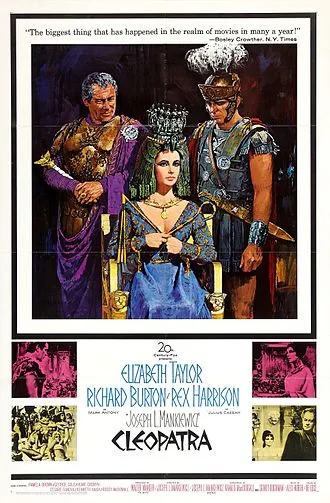Historical accuracy of Cleopatra

Historical accuracy of Cleopatra

Characters
Cleopatra VII (Elizabeth Taylor)
Based on the real queen, but portrayed through a 1960s lens of glamour and seduction. While historically intelligent and politically ambitious, the film emphasizes romance. Costumes are famously anachronistic, reflecting 1960s fashion more than ancient styles.
Julius Caesar (Rex Harrison)
Based on the real historical figure. Harrison's portrayal captures Caesar's intelligence and political calculation, though perhaps less overtly militaristic than reality. Generally a respected performance within the film's context.
Mark Antony (Richard Burton)
Based on the real historical figure. Burton's portrayal captures Antony's passion and military background but heavily emphasizes the consuming, tragic romance with Cleopatra, potentially simplifying his political motivations.
Octavian / Augustus (Roddy McDowall)
Based on the future Emperor Augustus. McDowall's portrayal as cold, calculating, intelligent, and politically ruthless is widely considered one of the film's most historically accurate characterizations.
High Priestess (Pamela Brown)
Likely a composite or fictional character representing Cleopatra's connection to Egyptian religion and court life.
Rufio (Martin Landau)
Based loosely on historical figures associated with Antony, representing his military command structure.
More characters
Apollodorus (Cesare Danova)
Likely based on Apollodorus the Sicilian, mentioned by Plutarch as helping Cleopatra meet Caesar. His expanded role is likely fictionalized.
Ptolemy XIII (Richard O'Sullivan)
Accurately depicted as Cleopatra's young brother and co-ruler, manipulated by court advisors and ultimately defeated in conflict with Caesar and Cleopatra.
Calpurnia (Gwen Watford)
Accurately depicted as Caesar's Roman wife.
Octavia (Jean Marsh)
Accurately portrayed as Antony's politically motivated Roman wife, caught between her brother and husband.
Marcus Vipsanius Agrippa (Andrew Keir)
Accurately depicted as Octavian's highly competent military commander, instrumental in the victory at Actium.
Caesarion
Accurately depicted as the son of Cleopatra and Caesar, whose existence was a key political factor.
Story
Caesar's arrival in Egypt / Pursuit of Pompey (48 BC)
Accurately depicts Caesar arriving in Egypt while pursuing his rival Pompey the Great during the Roman civil war.
Cleopatra smuggled to Caesar in a carpet
Based on Plutarch's account, though he likely described a more mundane "bedding sack." The film uses the more dramatic (and probably inaccurate) carpet imagery, popularized by earlier depictions.
Cleopatra and Caesar's affair and son (Caesarion)
Their political alliance and personal relationship, resulting in the birth of Caesarion, are historical facts.
Alexandrian War
The conflict between Caesar/Cleopatra's forces and those supporting Ptolemy XIII in Alexandria is historically accurate.
Cleopatra's visit to Rome (46-44 BC)
Cleopatra did reside in Rome as Caesar's guest prior to his assassination.
Assassination of Julius Caesar (44 BC)
The assassination is a key historical event occurring while Cleopatra is in Rome, accurately setting the stage for the subsequent power struggles.
Antony and Cleopatra's meeting / alliance / affair
Their famous meeting (Cleopatra arriving on a barge at Tarsus), subsequent political alliance, and passionate love affair are historical facts.
Donations of Alexandria (34 BC)
Antony's public declaration granting eastern territories to Cleopatra and their children (including declaring Caesarion Caesar's true heir) was a real event that outraged Rome.
Conflict between Antony/Cleopatra and Octavian
The escalating political and military conflict between the two factions, leading to the final war of the Republic, is historically accurate.
Battle of Actium (31 BC)
The decisive naval battle occurred, and Antony and Cleopatra were defeated by Octavian's forces under Agrippa. However, the film's depiction of the battle itself is highly inaccurate tactically and in ship design.
Suicide of Mark Antony (30 BC)
Antony did commit suicide (by sword) after falsely hearing Cleopatra was dead, following their defeat.
Suicide of Cleopatra (30 BC)
Cleopatra did commit suicide to avoid being paraded in Octavian's triumph. The film depicts the traditional (but possibly inaccurate) method of death by asp bite; poisoning is also debated by historians.
Setting
Rome (Mid-1st Century BC)
Grand sets evoke Roman power and architecture (Forum, villas, Senate) but often prioritize 1960s epic scale and aesthetic over strict archaeological accuracy for the specific period.
Egypt (Alexandria, Mid-1st Century BC)
Lavish sets depict Ptolemaic Alexandria's palaces and harbor. Blends Greco-Roman and Egyptian motifs in a stylized way, not necessarily an accurate reflection of Hellenistic Egypt.
Costumes
Costumes are famously inaccurate, especially for Cleopatra. They heavily reflect 1960s high fashion (cuts, fabrics, makeup) rather than historically accurate Egyptian, Greek, or Roman attire.
Architecture
Impressive in scale and ambition, but architectural details often blend different periods or prioritize visual impact over historical authenticity for 1st century BC Rome and Egypt.
Roman Military Appearance
Legionary armor and standards are depicted in a generalized "Hollywood Roman" style, adequate for visual identification but not always precise for the specific timeframe.
Naval Vessels (Actium)
The ships depicted in the Battle of Actium scene do not accurately represent the types of warships (like quinqueremes) used during that period.
Lifestyles of Rulers
Successfully conveys the immense wealth, power, political intrigue, and opulent lifestyles associated with rulers like Caesar, Cleopatra, and Antony.
General Atmosphere
Captures the epic scale, political turmoil, and clash of cultures (Roman ambition vs. Hellenistic Egypt) central to the historical period, albeit in a highly dramatized manner.
